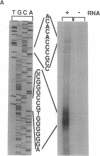Abstract
The parathyroid hormone/parathyroid hormone-related peptide receptor (PTHR) is a G-protein-coupled receptor containing seven predicted transmembrane domains. We have isolated and characterized recombinant bacteriophage lambda EMBL3 genomic clones containing the mouse PTHR gene, including 10 kilobases of the promoter region. The gene spans > 32 kilobases and is divided into 15 exons, 8 of which contain the transmembrane domains. The PTHR exons containing the predicted membrane-spanning domains are heterogeneous in length and three of the exon-intron boundaries fall within putative transmembrane sequences, suggesting that the exons did not arise from duplication events. This arrangement is closely related to that of the growth hormone releasing factor receptor gene, particularly in the transmembrane region, providing strong evidence that the two genes evolved from a common precursor. Transcription is initiated principally at a series of sites over a 15-base-pair region. The proximal promoter region is highly (G+C)-rich and lacks an apparent TATA box or initiator element homologies but does contain CCGCCC motifs. The presumptive amino acid sequence of the encoded receptor is 99%, 91%, and 76% identical to those of the rat, human, and opossum receptors, respectively. There is no consensus polyadenylation signal in the 3' untranslated region. The poly(A) tail of the PTHR transcript begins 32 bases downstream of a 35-base-long A-rich sequence, suggesting that this region directs polyadenylylation.
Full text
PDF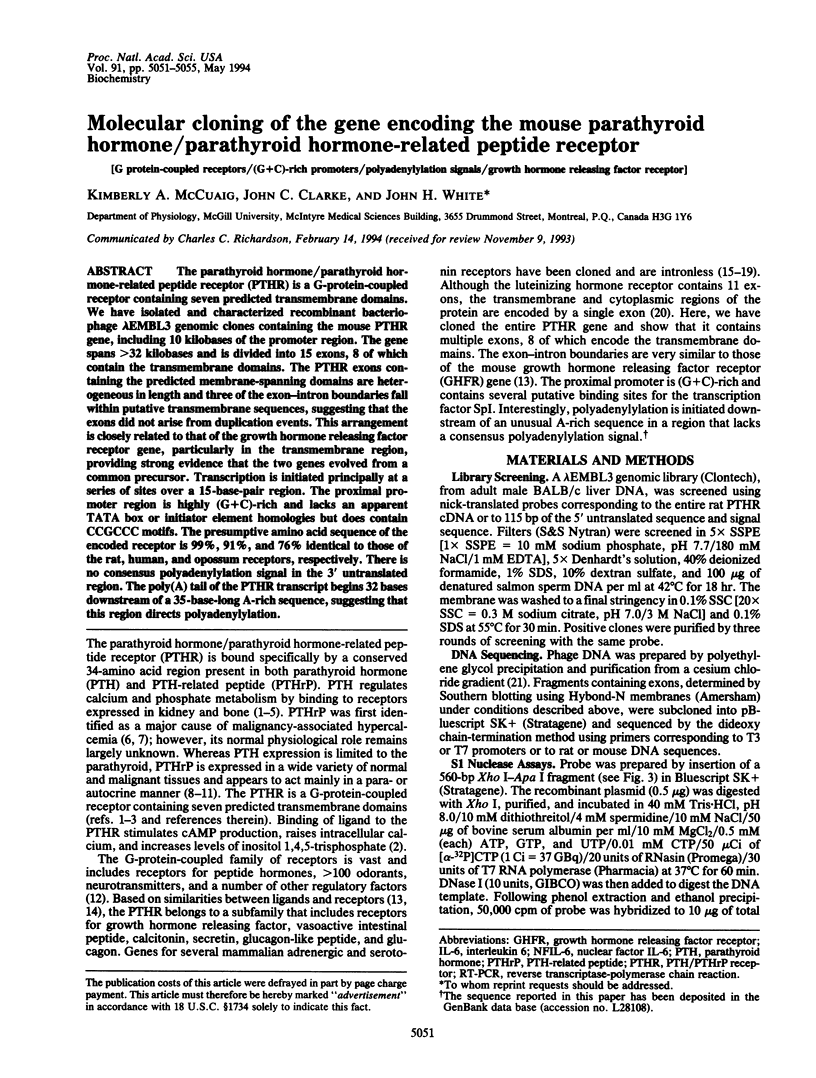
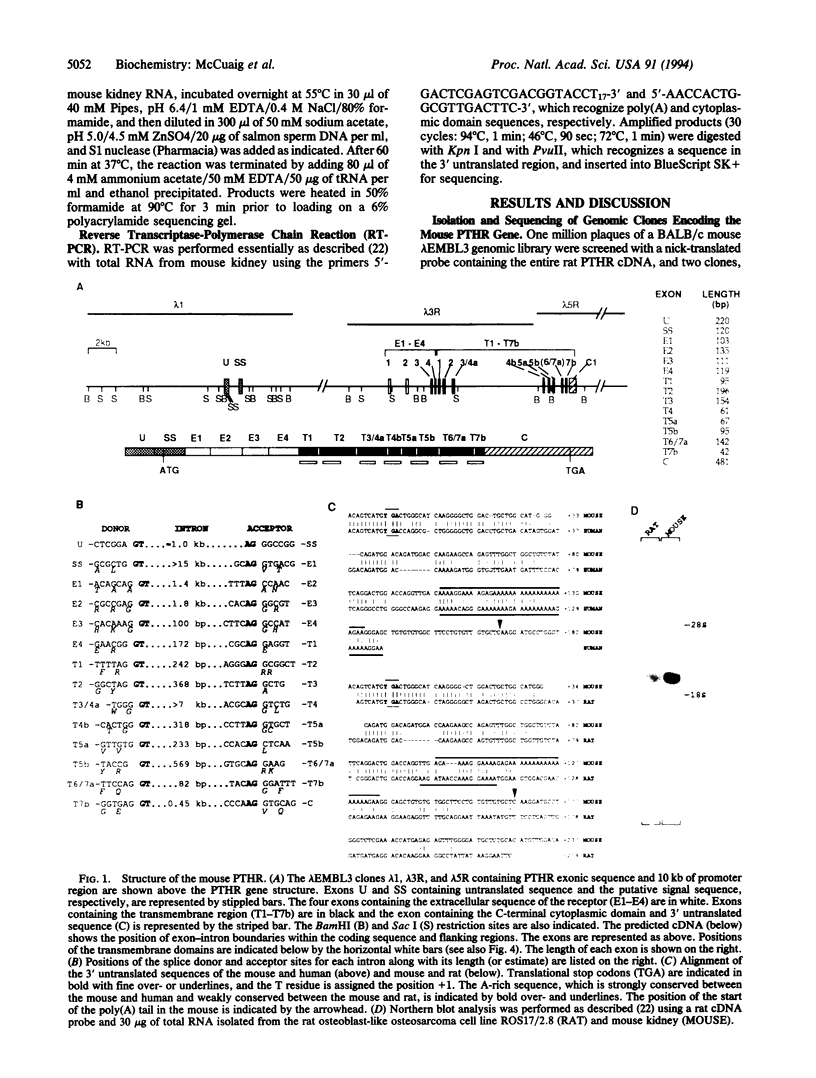
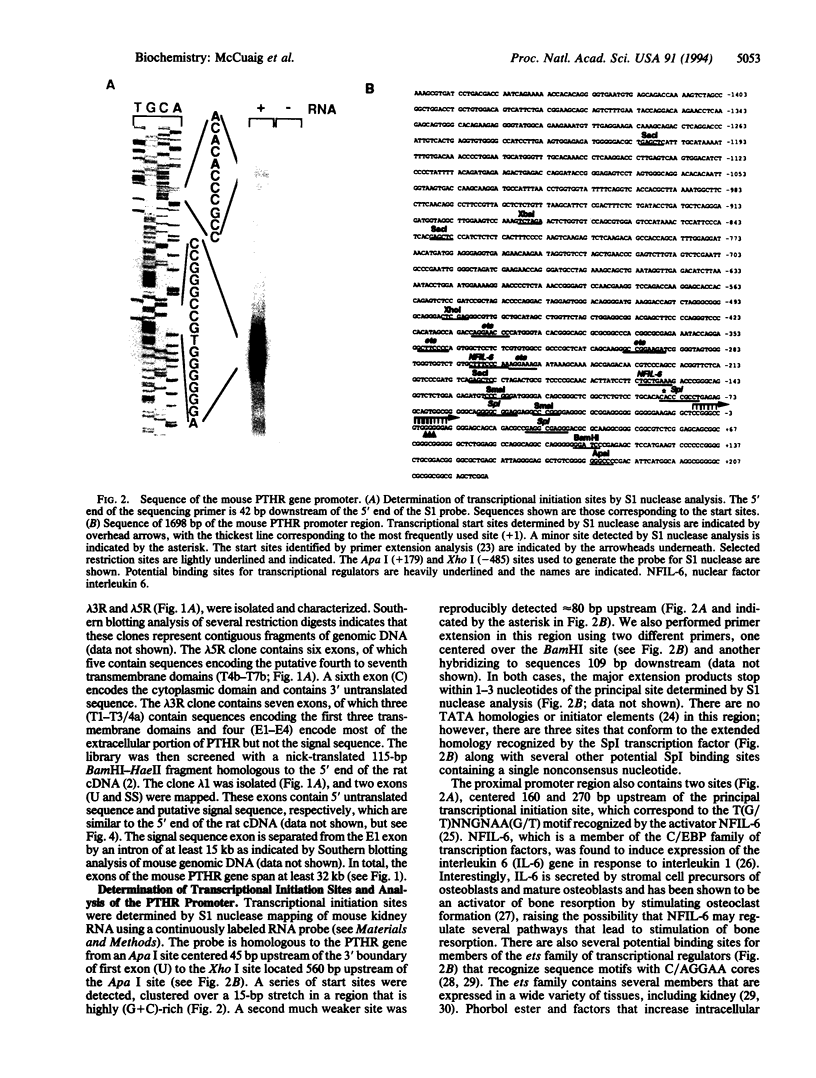
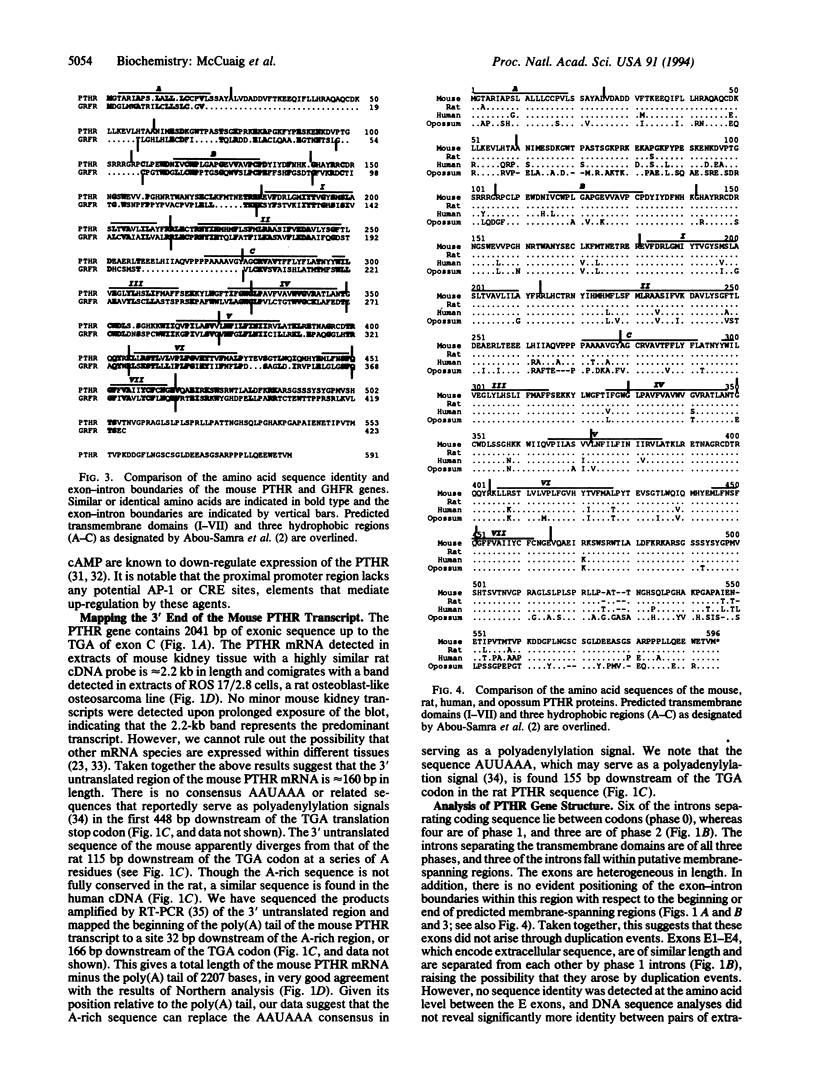
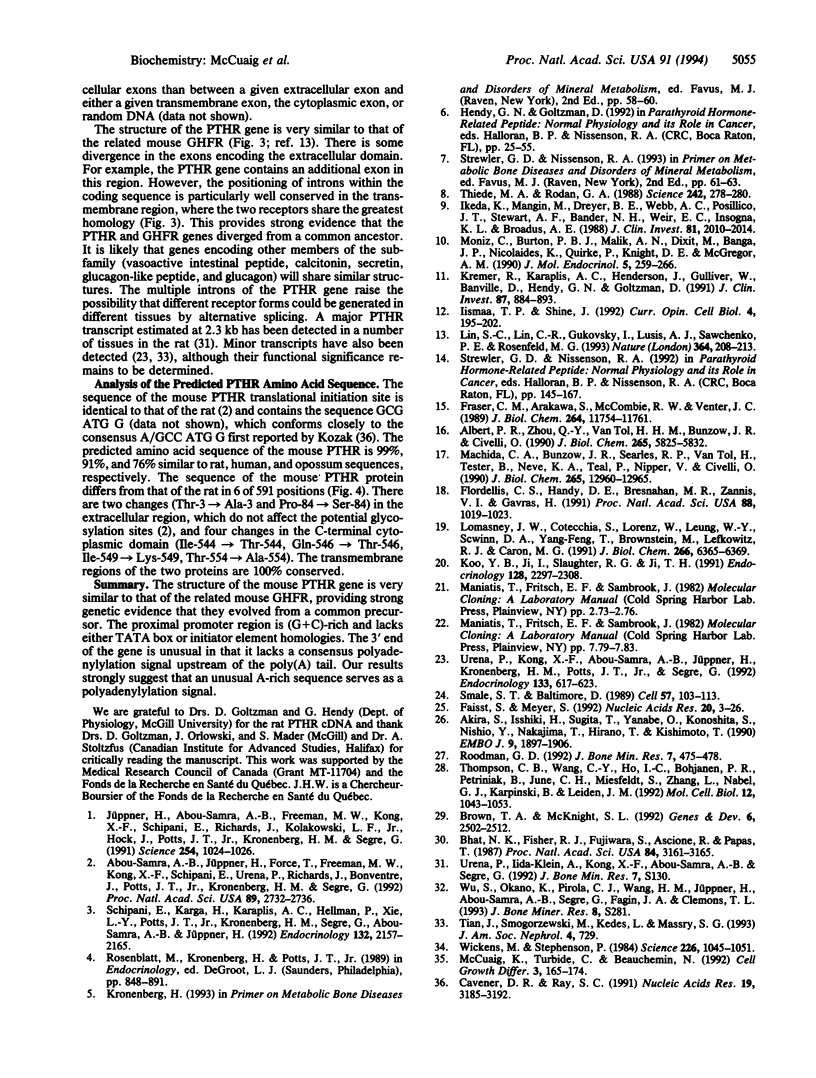
Images in this article
Selected References
These references are in PubMed. This may not be the complete list of references from this article.
- Abou-Samra A. B., Jüppner H., Force T., Freeman M. W., Kong X. F., Schipani E., Urena P., Richards J., Bonventre J. V., Potts J. T., Jr Expression cloning of a common receptor for parathyroid hormone and parathyroid hormone-related peptide from rat osteoblast-like cells: a single receptor stimulates intracellular accumulation of both cAMP and inositol trisphosphates and increases intracellular free calcium. Proc Natl Acad Sci U S A. 1992 Apr 1;89(7):2732–2736. doi: 10.1073/pnas.89.7.2732. [DOI] [PMC free article] [PubMed] [Google Scholar]
- Akira S., Isshiki H., Sugita T., Tanabe O., Kinoshita S., Nishio Y., Nakajima T., Hirano T., Kishimoto T. A nuclear factor for IL-6 expression (NF-IL6) is a member of a C/EBP family. EMBO J. 1990 Jun;9(6):1897–1906. doi: 10.1002/j.1460-2075.1990.tb08316.x. [DOI] [PMC free article] [PubMed] [Google Scholar]
- Albert P. R., Zhou Q. Y., Van Tol H. H., Bunzow J. R., Civelli O. Cloning, functional expression, and mRNA tissue distribution of the rat 5-hydroxytryptamine1A receptor gene. J Biol Chem. 1990 Apr 5;265(10):5825–5832. [PubMed] [Google Scholar]
- Bhat N. K., Fisher R. J., Fujiwara S., Ascione R., Papas T. S. Temporal and tissue-specific expression of mouse ets genes. Proc Natl Acad Sci U S A. 1987 May;84(10):3161–3165. doi: 10.1073/pnas.84.10.3161. [DOI] [PMC free article] [PubMed] [Google Scholar]
- Brown T. A., McKnight S. L. Specificities of protein-protein and protein-DNA interaction of GABP alpha and two newly defined ets-related proteins. Genes Dev. 1992 Dec;6(12B):2502–2512. doi: 10.1101/gad.6.12b.2502. [DOI] [PubMed] [Google Scholar]
- Cavener D. R., Ray S. C. Eukaryotic start and stop translation sites. Nucleic Acids Res. 1991 Jun 25;19(12):3185–3192. doi: 10.1093/nar/19.12.3185. [DOI] [PMC free article] [PubMed] [Google Scholar]
- Faisst S., Meyer S. Compilation of vertebrate-encoded transcription factors. Nucleic Acids Res. 1992 Jan 11;20(1):3–26. doi: 10.1093/nar/20.1.3. [DOI] [PMC free article] [PubMed] [Google Scholar]
- Flordellis C. S., Handy D. E., Bresnahan M. R., Zannis V. I., Gavras H. Cloning and expression of a rat brain alpha 2B-adrenergic receptor. Proc Natl Acad Sci U S A. 1991 Feb 1;88(3):1019–1023. doi: 10.1073/pnas.88.3.1019. [DOI] [PMC free article] [PubMed] [Google Scholar]
- Fraser C. M., Arakawa S., McCombie W. R., Venter J. C. Cloning, sequence analysis, and permanent expression of a human alpha 2-adrenergic receptor in Chinese hamster ovary cells. Evidence for independent pathways of receptor coupling to adenylate cyclase attenuation and activation. J Biol Chem. 1989 Jul 15;264(20):11754–11761. [PubMed] [Google Scholar]
- Iismaa T. P., Shine J. G protein-coupled receptors. Curr Opin Cell Biol. 1992 Apr;4(2):195–202. doi: 10.1016/0955-0674(92)90033-9. [DOI] [PubMed] [Google Scholar]
- Ikeda K., Mangin M., Dreyer B. E., Webb A. C., Posillico J. T., Stewart A. F., Bander N. H., Weir E. C., Insogna K. L., Broadus A. E. Identification of transcripts encoding a parathyroid hormone-like peptide in messenger RNAs from a variety of human and animal tumors associated with humoral hypercalcemia of malignancy. J Clin Invest. 1988 Jun;81(6):2010–2014. doi: 10.1172/JCI113551. [DOI] [PMC free article] [PubMed] [Google Scholar]
- Jüppner H., Abou-Samra A. B., Freeman M., Kong X. F., Schipani E., Richards J., Kolakowski L. F., Jr, Hock J., Potts J. T., Jr, Kronenberg H. M. A G protein-linked receptor for parathyroid hormone and parathyroid hormone-related peptide. Science. 1991 Nov 15;254(5034):1024–1026. doi: 10.1126/science.1658941. [DOI] [PubMed] [Google Scholar]
- Koo Y. B., Ji I., Slaughter R. G., Ji T. H. Structure of the luteinizing hormone receptor gene and multiple exons of the coding sequence. Endocrinology. 1991 May;128(5):2297–2308. doi: 10.1210/endo-128-5-2297. [DOI] [PubMed] [Google Scholar]
- Kremer R., Karaplis A. C., Henderson J., Gulliver W., Banville D., Hendy G. N., Goltzman D. Regulation of parathyroid hormone-like peptide in cultured normal human keratinocytes. Effect of growth factors and 1,25 dihydroxyvitamin D3 on gene expression and secretion. J Clin Invest. 1991 Mar;87(3):884–893. doi: 10.1172/JCI115094. [DOI] [PMC free article] [PubMed] [Google Scholar]
- Lin S. C., Lin C. R., Gukovsky I., Lusis A. J., Sawchenko P. E., Rosenfeld M. G. Molecular basis of the little mouse phenotype and implications for cell type-specific growth. Nature. 1993 Jul 15;364(6434):208–213. doi: 10.1038/364208a0. [DOI] [PubMed] [Google Scholar]
- Lomasney J. W., Cotecchia S., Lorenz W., Leung W. Y., Schwinn D. A., Yang-Feng T. L., Brownstein M., Lefkowitz R. J., Caron M. G. Molecular cloning and expression of the cDNA for the alpha 1A-adrenergic receptor. The gene for which is located on human chromosome 5. J Biol Chem. 1991 Apr 5;266(10):6365–6369. [PubMed] [Google Scholar]
- Machida C. A., Bunzow J. R., Searles R. P., Van Tol H., Tester B., Neve K. A., Teal P., Nipper V., Civelli O. Molecular cloning and expression of the rat beta 1-adrenergic receptor gene. J Biol Chem. 1990 Aug 5;265(22):12960–12965. [PubMed] [Google Scholar]
- McCuaig K., Turbide C., Beauchemin N. mmCGM1a: a mouse carcinoembryonic antigen gene family member, generated by alternative splicing, functions as an adhesion molecule. Cell Growth Differ. 1992 Mar;3(3):165–174. [PubMed] [Google Scholar]
- Moniz C., Burton P. B., Malik A. N., Dixit M., Banga J. P., Nicolaides K., Quirke P., Knight D. E., McGregor A. M. Parathyroid hormone-related peptide in normal human fetal development. J Mol Endocrinol. 1990 Dec;5(3):259–266. doi: 10.1677/jme.0.0050259. [DOI] [PubMed] [Google Scholar]
- Roodman G. D. Interleukin-6: an osteotropic factor? J Bone Miner Res. 1992 May;7(5):475–478. doi: 10.1002/jbmr.5650070502. [DOI] [PubMed] [Google Scholar]
- Schipani E., Karga H., Karaplis A. C., Potts J. T., Jr, Kronenberg H. M., Segre G. V., Abou-Samra A. B., Jüppner H. Identical complementary deoxyribonucleic acids encode a human renal and bone parathyroid hormone (PTH)/PTH-related peptide receptor. Endocrinology. 1993 May;132(5):2157–2165. doi: 10.1210/endo.132.5.8386612. [DOI] [PubMed] [Google Scholar]
- Smale S. T., Baltimore D. The "initiator" as a transcription control element. Cell. 1989 Apr 7;57(1):103–113. doi: 10.1016/0092-8674(89)90176-1. [DOI] [PubMed] [Google Scholar]
- Thiede M. A., Rodan G. A. Expression of a calcium-mobilizing parathyroid hormone-like peptide in lactating mammary tissue. Science. 1988 Oct 14;242(4876):278–280. doi: 10.1126/science.3175653. [DOI] [PubMed] [Google Scholar]
- Thompson C. B., Wang C. Y., Ho I. C., Bohjanen P. R., Petryniak B., June C. H., Miesfeldt S., Zhang L., Nabel G. J., Karpinski B. cis-acting sequences required for inducible interleukin-2 enhancer function bind a novel Ets-related protein, Elf-1. Mol Cell Biol. 1992 Mar;12(3):1043–1053. doi: 10.1128/mcb.12.3.1043. [DOI] [PMC free article] [PubMed] [Google Scholar]
- Ureña P., Kong X. F., Abou-Samra A. B., Jüppner H., Kronenberg H. M., Potts J. T., Jr, Segre G. V. Parathyroid hormone (PTH)/PTH-related peptide receptor messenger ribonucleic acids are widely distributed in rat tissues. Endocrinology. 1993 Aug;133(2):617–623. doi: 10.1210/endo.133.2.8393771. [DOI] [PubMed] [Google Scholar]
- Wickens M., Stephenson P. Role of the conserved AAUAAA sequence: four AAUAAA point mutants prevent messenger RNA 3' end formation. Science. 1984 Nov 30;226(4678):1045–1051. doi: 10.1126/science.6208611. [DOI] [PubMed] [Google Scholar]




